|
Animal globetrotters III
Spectacular mammal journeys
 Even
though there are less long distance travellers among mammals and
reptiles than among birds, insects and fishes, the fantastic journeys
they make are certainly worth exploring. Even
though there are less long distance travellers among mammals and
reptiles than among birds, insects and fishes, the fantastic journeys
they make are certainly worth exploring.
From little lemmings to mighty whales, a wide range of different
mammals undertake spectacular long distance journeys by land or sea,
every year. Of all these journeys, the most incredible voyages are
accomplished by certain species of aquatic marine mammals, particularly
members of the whale order. So, let's check out some of these incredible
mammal migrations today...
Research into mammal migration has revealed that the grey whale
undertakes the longest confirmed journey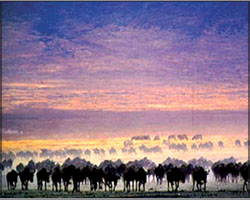 which can average a distance of 10,000-14,000 mile round trip.
which can average a distance of 10,000-14,000 mile round trip.
It travels from its summer feeding grounds in the Arctic, in the
waters of the Bering Sea between Alaska and Siberia, to its winter
breeding grounds located off Baja California in northern Mexico.
What's incredible is that the grey whale swims this great distance in
a speedy 90 days, twice a year during its migratory cycle. The Blue
whale too migrates. It spends its winter in temperate and sub-tropical
regions. When spring and summer arrives, it swims to the polar regions
to feed in the waters of melting ice caps.
Humpback whales are another species that migrate, but they do so on
defined migratory routes. Whether from the northern or southern
hemisphere, humpback whales follow the same annual migration pattern
every year.
They move from the krill-rich waters of the poles, to the warm waters
of the equator, to give birth. Research has revealed that humpbacks
travel from the Caribbean to Greenland and Iceland, from Hawaii to
Alaska, and
 from
the Atlantic Ocean to Colombia in South America. Dolphins and porpoises
too migrate. However, their migratory routes are not as well defined as
that of whales. from
the Atlantic Ocean to Colombia in South America. Dolphins and porpoises
too migrate. However, their migratory routes are not as well defined as
that of whales.
On land, there are many species of mammals that are long distance
travellers. Mass migrations are rather common among certain species,
even though the numbers have reduced drastically due to hunting.
The Alaskan fur seal lives in colonies in their breeding grounds in
the north. The females travel south each winter to feed in Southern
California. While the males remain in the northern waters by the
Aleutian Islands, the females journey some 5,000 km southwards each year
during September and October.
During the spring however, they return to their colder breeding
grounds in the Commander and Pribilof Islands in the Bering Sea and Japan's Sakhalin Island.
in the Bering Sea and Japan's Sakhalin Island.
Several species of hoofed mammals such as springboks, gnus and
American bison too migrate in large numbers. The blue gnus or
wildebeests overcome many obstacles on their mass migrations, sometimes
even crossing large rivers.
Another famous mammal species that emigrates in large numbers are the
lemmings. This small herbivorous mammal has a formidable reproduction
rate - more than 100 offspring can be born to a single pair within six
months! And so, you can imagine then how fast their population grows.
This naturally leads to a scarcity of food within a given area of the
Scandinavian tundra and the scrub that comprises their normal habitat.
And when the population size reaches 40-100 individuals per acre,
which tends to happen every three to five years, the lemmings emigrate
in search of food. However, during this mass emigration, many lemmings
die.
Many suffer from the effects of acute overcrowding and
disorganisation. They become exhausted and behave in a frenzied manner;
they drown in rivers and even fall down cliffs.
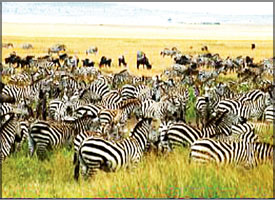 In
early days, researchers were of the view that the lemmings were In
early days, researchers were of the view that the lemmings were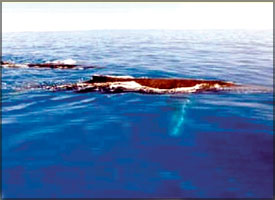 committing suicide, but today, it is believed that such action is due to
their inability to change course in time. Researchers are also of the
view that the eating of toxic plants due to the scarcity of food maybe
causing the lemmings to behave in a frenzied manner.
committing suicide, but today, it is believed that such action is due to
their inability to change course in time. Researchers are also of the
view that the eating of toxic plants due to the scarcity of food maybe
causing the lemmings to behave in a frenzied manner.
The only mammal equipped with the power of true flights, bats, also
travel considerable distances in their migratory journeys, like their
counterparts in the avian world. Some exhibit true migration, that is
they fly from their summer breeding grounds to their wintering grounds,
and six months later, do a turn around to return to their home, to breed
again.
Australia's grey-headed fruit bats are known to travel more than
1,600 km (1,000 miles) between October and December from Queensland to
Victoria. Even the American red bat migrates from Canada and northern
United States to the southernmost regions of the United States and even
upto Bermuda, which covers a distance of about 900 km. They often make
these long-distance journeys in single-gender flocks. Adult females each
carry upto three infants during their mass migrations.
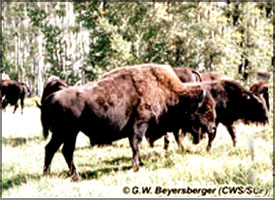 Now
don't you think that the long distance journeys these animals make Now
don't you think that the long distance journeys these animals make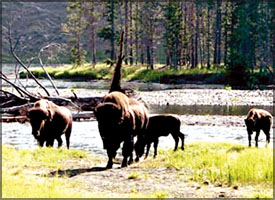 are fantastic, simply because they do so using their own energy and
inert knowledge; they don't have powered vehicles, maps and other
guiding information to undertake these long journeys. Majority of these
animals migrate for food and breeding purposes.
are fantastic, simply because they do so using their own energy and
inert knowledge; they don't have powered vehicles, maps and other
guiding information to undertake these long journeys. Majority of these
animals migrate for food and breeding purposes.
A change in temperature, drought and shortage of food generally
determines an initiation of immigration. As they rely on the climate and
cues from the environment to make successful journeys, climatic changes
and destruction of natural habitats have a drastic impact on animal
migration.
This is something we should always keep in mind when we destroy vast
expanses of forest land and change the landscape in animal migratory
routes. As we explained, earlier, there are many more species of animals
that migrate in the animal kingdom. Next week too, we'll bring you some
interesting facts about such migrations. |
